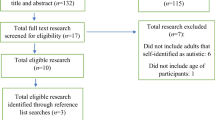Abstract
Background and objectives
This study examined the level of agreement between parents and children on the Strengths and Difficulties Questionnaire (SDQ) in a clinical sample in Sydney, Australia.
Methods
Parent and child SDQ reports were collected from 379 parents-child pairs. Children were aged between 11 and 18 years and met criteria for at least one psychiatric diagnosis.
Results
Overall agreement between children and parents was low to modest. Sixty nine percent of parent-child pairs agreed that the child’s problems were either clinically significant or not (“neither”, “both”), while in 27% of pairs only the parents regarded the problems as clinically significant (“parent only”), and in 4% of pairs only the children regarded the problems as clinically significant. There was higher agreement for children with mood, anxiety or somatoform disorders. Children with mood disorders were over-represented in the “child only” group, and those with conduct disorders were more likely to be in the “parent only” group. Children with anxiety and somatoform disorders were more likely to be in the “neither” group. Age was not associated with rates of parent-child agreement, however more girls agreed with their parents that either they did not have a problem (“neither”) or they did have a problem without parental endorsement (“child only”).
Conclusions
This study highlights the limited agreement between parent and child reports of problem behaviour and the importance of integrating discrepant information into child and adolescent mental health assessments, formulations and treatments.


Similar content being viewed by others
References
Achenbach TM, McConaughy SH, Howell CT (1987) Child/adolescent behavioural and emotional problems: implications of cross-informant correlations for situational specificity. Psychol Bull 101:213–232
American Psychiatric Association (1994) Diagnostic and statistical manual of mental disorders, 4th edn. Author, Washington
Becker A, Hasenberg N, Roesnner V, Woerner W, Rothenberger A (2004) Evaluation of the self-reported SDQ in a clinical setting: do self-reports tell us more than ratings by adult informants? Eur Child Adolesc Psychiatry 13:II/17–II/24
Choudhury M, Pimentel S, Kendall P (2003) Childhood anxiety disorders: parent-child (dis)agreement using a structured interview for the DSM-IV. J Am Child Adolesc Psychiatry 42:957–964
Goodman R (1997) The strengths and difficulties questionnaire: a research note. J Child Psychol Psychiatry 38: 581–6
Goodman R, Ford T, Simmons H, Gatward R, Meltzer H (2000) Using the strengths and difficulties questionnaire (SDQ) to screen for child psychiatric disorders in a community sample. Br J Psychiatry 177: 534–539
Handwerk M, Larzelere R, Soper S (1999) Parent and child discrepancies in reporting severity of problem behaviors in three out-of-home settings. Psychol Assess 11:14–23
Hawes D, Dadds M (2004) Australian data and psychometric properties of the strenghts and difficulties questionnaire. Aust NZ J Psychiatry 38:644–651
Karver M (2006) Determinants of multiple informant agreement on child and adolescent behavior. J Abnorm Child Psychol 34:251–262
Martin J, Ford C, Tang J, Huffman L (2004) Patterns of agreement between parent and child ratings of emotional and behavioral problems in an outpatient clinical setting: When children endorse more problems. Dev Behav Pediatr 25:150–155
Mathai J, Anderson P, Bourne A (2004) Comparing psychiatric diagnosis generated by the strengths and difficulties questionnaire with diagnoses made by clinicians. Aust NZ J Psychiatry 38:639–643
Offord DR, Boyle MH, Racine Y, Szatmari P, Fleming JE, Sanford M, Lipman EL (1996) Integrating assessment data from multiple informants. J Am Acad Child Adolesc Psychiatry 35:1078–1085
Peat J, Barton B (2005) Medical statistics: a guide to data analysis and critical appraisal. Blackwell, Oxford
Sawyer M, Arney F, Baghurst P, Clark J, Graetz B, Kosky R, Nurcombe B, Patton G, Prior M, Raphael B, Rey J, Whaites L, Zubrick S (2000) Mental health of young people in Australia: child and adolescent component of the National Survey of Mental Health and Well Being. Commonwealth Department of Health and Aged Care, Canberra
Verhulst F, Ende J van der (1992) Agreement between parents’ reports and adolescents’ self-reports of problem behavior. J Child Psychol Psychiatry 33:1011–1023
Yeh M, Weisz JR (2001) Why are we here at the clinic? Parent-child disagreement on referral problems at outpatient treatment entry. J Consult Clin Psychol 69:1018–1025
Younstrom E, Loeber R, Stouthamer-Loeber M (2000) Patterns and correlates of agreement between parent, teacher, and male adolescent ratings of externalizing and internalizing problems. J Consult Clin Psychol 68:1038–1050
Acknowledgments
The authors would like to thank Professor Jennifer Peat for her statistical advice and comments on the manuscript and Ms Malini Sivabalan for her assistance with data mining and retrieval.
Author information
Authors and Affiliations
Corresponding author
Rights and permissions
About this article
Cite this article
van der Meer, M., Dixon, A. & Rose, D. Parent and child agreement on reports of problem behaviour obtained from a screening questionnaire, the SDQ. Eur Child Adolesc Psychiatry 17, 491–497 (2008). https://doi.org/10.1007/s00787-008-0691-y
Accepted:
Published:
Issue Date:
DOI: https://doi.org/10.1007/s00787-008-0691-y




